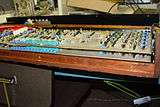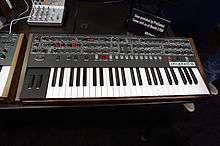Sequential Circuits Prophet-5
| Prophet-5 | |
|---|---|
 | |
| Manufacturer | Sequential Circuits |
| Dates | 1978–84 |
| Price |
US$4,495 (Rev 1, 2) US$3,995 (Rev 3) |
| Technical specifications | |
| Polyphony | 5 voices |
| Timbrality | Monotimbral |
| Oscillator | 2 VCOs per voice |
| LFO | 1 |
| Synthesis type |
Analog subtractive Analog FM (Poly-Mod) |
| Filter | 4-pole resonant low-pass |
| Attenuator | ADSR envelope (2) |
| Aftertouch expression | No |
| Velocity expression | No |
| Storage memory | 40 patches (120 patches on later units) |
| Effects | None |
| Input/output | |
| Keyboard | 61 keys |
| Left-hand control | Pitch and modulation wheels |
| External control | CV/Gate |
The Prophet-5 is an analog synthesizer that was designed and manufactured by Sequential Circuits between 1978 and 1984. With five voices of polyphony, the Prophet-5 is one of the first polyphonic analog synthesizers with patch memory. About 6,000 units were produced in three revisions by Dave Smith and John Bowen. This was later accompanied by the Prophet-10, a version with ten voices of polyphony through an additional circuit board and keyboard.
The Prophet-5 is known for its use by progressive rock bands and film composers. Due to its success, the Prophet-5 has been emulated in software synthesizers and analog hardware. Through his company Dave Smith Instruments, and later under the Sequential Circuits brand, Smith has developed updated versions of the Prophet-5.
Production history
The Prophet-5 was developed by Dave Smith and John Bowen for Sequential Circuits, with the goal of creating a true polyphonic analog synthesizer with the ability to store and recall patches. Initially, they developed the Prophet-10, a synthesizer with ten voices of polyphony; however, these were extremely unstable and overheated almost immediately. As a result, Smith and Bowen pared back the number of voices to five, which led to the Prophet-5.[1]
There were three "revisions" of the Prophet-5 between 1978 and 1984. The first, Revision 1, is the least common, with 182 units having been produced. Revision 1 Prophet-5s were primarily hand-assembled by Smith and Bowen, and housed in a koa wood casing. Revision 2, which was mass-produced in quantities over 1,000, saw the addition of cassette patch storage (with a memory of up to 40 patches) and a walnut casing.[1] By Revision 3.3, the memory storage had expanded to 120 patches. However, Revision 3 also introduced new circuitry that increased the stability but decreased the warmth of the Prophet-5.[2] Revision 3 is the most common version.[3] Inclusive of all revisions, approximately 6,000 units were produced.[1]

Following the success of the Prophet-5, Smith and Bowen reintroduced the Prophet-10. This was achieved by simply stacking two Revision 3 Prophet-5 sound boards, which were played with two separate keyboards. Early Prophet-10s were still prone to overheating and unstable tuning, as well as memory issues.[4] The Prophet-10 was not as successful as the Prophet-5.[1]
Synthesis model
Oscillators
Early Prophet-5s used voltage-controlled oscillator, filter and amplifier chips designed by E-mu Systems and manufactured by Solid State Microelectronics (SSM). Revision 3 Prophet-5s used Curtis CEM chips. Some owners maintain that SSM oscillators produced a richer timbre.[2] However, the SSM oscillators rendered the instruments unstable and prone to detuning over time. CEM chips have remained more stable.[3]
The Prophet-5 uses five voices of polyphony. Each voice is assigned two VCOs. Both oscillators can generate sawtooth waves and square waves (with variable pulse width), and the second oscillator can also generate a triangle. The oscillators can be played in sync, or in "Poly-Mod", with oscillator B and the filter ADSR envelope modulating the frequency, pulse width, and filter of oscillator A. A dedicated low-frequency oscillator (saw, square, or triangle) is also present to modulate the pulse width and/or pitch of oscillators A and B and filter cutoff frequency.[2]
Filter
The Prophet-5 uses a 4-pole resonant low-pass filter. The filter has a dedicated ADSR envelope and keyboard tracking.
Clones and emulators
Software

Arturia developed a softsynth version of the Prophet 5 called the Prophet V. Prophet V also includes a recreation of the Prophet VS, a synthesizer manufactured by Sequential Circuits in 1986. Elements of the two synthesizers can be combined in a "hybrid" mode. The softsynth closely recreates the layout of the original analog synthesizer, though there were some differences in programming, notably through some restrictions on the envelope generator.[5]
Other software emulations of the Prophet-5 include Pro-53, a Virtual Studio Technology and Audio Unit by Native Instruments (discontinued in 2009), Prophecizer 5 by Analog Synth Lab, and the Pro-12 by Creamware. The Pro-12 emulates the early revisions' SSM filter. Creamware has also developed and manufactures a hardware version of the Pro-12 called the Pro-12 ASB.
Hardware

Dave Smith Instruments celebrated the 30th anniversary of the Prophet by developing the Prophet '08, an 8-voice analog synthesizer. Smith was the owner of Sequential Circuits until it went out of business in the late 1980s when the rights were purchased by Yamaha and later sold to Korg. Smith was a consultant for Yamaha and Korg for a number of years following the acquisition. He was largely responsible for Korg's successful Wavestation series of vector-synthesis-based instruments.
With access to the technology used to create the Prophet-5, Yamaha developed the 1997 virtual analog synthesizer keyboard, the AN1x. Many of its features were modelled upon the Prophet-5. The AN1x surpassed capabilities of the Prophet-5, with a doubled 10 notes of polyphony and various other features either modelled on other popular analog synthesizers or representing new additions made feasibly only by the underlying digital technology.
In January 2015, Smith announced that Yamaha's president, Takuya Nakata, had granted him rights to the Sequential brand, which he had been unable to use following the company's acquisition. The release of the name coincided with Smith's debut of the Prophet-6, a new analog polyphonic synthesizer based on the Prophet-5 with additional features. Of the Prophet-6, Smith said "I wanted to celebrate the return of Sequential in the best way I could—by building the most awesome-sounding, modern analog poly synth possible. The Prophet-6 is a tribute to Sequential’s most famous instrument, the Prophet-5. I think of it as vintage with a modern twist."[6]
Artists who have used the Prophet-5 or Prophet-10
Notable artists and music groups who have used the Prophet-5 or Prophet-10 in their work include:[2]
- ABBA (Benny Andersson)
- deadmau5[7]
- Dieter Bohlen (of Modern Talking)[3]
- Doobie Brothers
- John Carpenter
- The Cars
- Vince Clarke
- Phil Collins
- Patrick Cowley
- Thomas Dolby
- Duran Duran
- Eurythmics
- Peter Gabriel
- Genesis – Tony Banks
- Hall & Oates
- Human League
- Iva Davies (of Icehouse)[8]
- Paul Davis
- INXS
- Jean-Michel Jarre
- Keff McCulloch[9]
- Japan
- Journey – Gregg Rolie[10]
- Kombi (band)
- Kraftwerk
- Philip Glass
- Madonna[11]
- Mannheim Steamroller
- New Order
- No Doubt
- Gary Numan
- Berlin
- Pat Metheny Group (Lyle Mays)
- Pet Shop Boys
- Pink Floyd
- Radiohead
- Skinny Puppy[12]
- Squeeze
- Steely Dan
- Talking Heads
- Thompson Twins
- Weather Report (Josef Zawinul)
References
| Wikimedia Commons has media related to Sequential Circuits Prophet-5. |
- 1 2 3 4 Reid, Gordon (March 1999). "Sequential Circuits – Prophet Synthesizers 5 & 10 (Retro)". Sound On Sound. Retrieved January 23, 2015.
- 1 2 3 4 "Sequential Circuits Prophet 5". Vintage Synth Explorer. Retrieved 2015-12-26.
- 1 2 3 Forrest, Peter (1996). The A-Z of Analogue Synthesisers Part Two. Short Run Press Ltd. p. 114.
- ↑ "Sequential Circuits Prophet 10". Vintage Synth Explorer. Retrieved January 23, 2015.
- ↑ Reid, Gordon (September 2006). "Arturia Prophet V". Sound on Sound. Retrieved January 23, 2015.
- ↑ "Sequential is Back!". Dave Smith Instruments. January 22, 2015. Retrieved January 23, 2015.
- ↑ http://www.youredm.com/2016/11/05/deadmau5-premieres-brand-new-track-on-bbc-radio-1/
- ↑ "Icehouse review". Electronics and Music Maker (E&MM) magazine. June 1986. Retrieved 2008-06-17.
- ↑ "Dr. Who Demonstration-BBCTV 'Corners'". 1987. Retrieved 2016-06-27.
- ↑ "A Session with Journey". Modern Recording magazine. April 1980. Retrieved 2016-03-17.
- ↑ "Madonna 'Like a Virign'". Sound on Sound. c. 1984. Retrieved 2016-07-31.
- ↑ Harriman, Andi (2014). Some Wear Leather, Some Wear Lace: The Worldwide Compendium of Postpunk and Goth in the 1980s. p. 78. ISBN 1783203528.
- ↑ Partridge & Bernhardt (2016). Complicated Game, ISBN 978-1-908279-78-1
.jpg)
